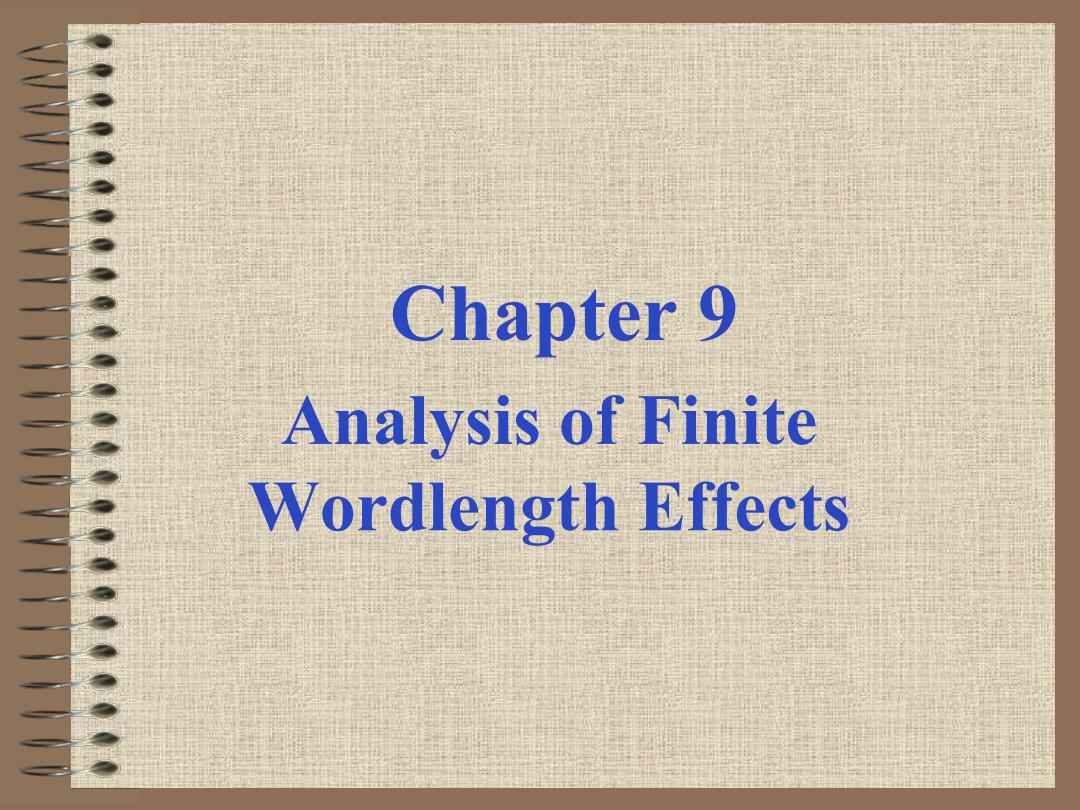
Chapter 9 Analysis of Finite Wordlength Effects
Chapter 9 Analysis of Finite Wordlength Effects

Introduction Ideally,the system parameters along with the signal variables have infinite precision taking any value between -co and co In practice,they can take only discrete values within a specified range since the registers of the digital machine where they are stored are of finite length The discretization process results in nonlinear difference equations characterizing the discrete-time systems
Introduction • Ideally, the system parameters along with the signal variables have infinite precision taking any value between -∞ and ∞ • In practice, they can take only discrete values within a specified range since the registers of the digital machine where they are stored are of finite length • The discretization process results in nonlinear difference equations characterizing the discrete-time systems

Introduction These nonlinear equations,in principle, are almost impossible to analyze and deal with exactly However,if the quantization amounts are small compared to the values of signal variables and filter parameters,a simpler approximate theory based on a statistical model can be applied
Introduction • These nonlinear equations, in principle, are almost impossible to analyze and deal with exactly • However, if the quantization amounts are small compared to the values of signal variables and filter parameters, a simpler approximate theory based on a statistical model can be applied

Introduction Using the statistical model,it is possible to derive the effects of discretization and develop results that can be verified experimentally Sources of errors (1)Filter coefficient quantization (2)A/D conversion (3)Quantization of arithmetic operations (4)Limit cycles
Introduction • Using the statistical model, it is possible to derive the effects of discretization and develop results that can be verified experimentally • Sources of errors - (1) Filter coefficient quantization (2) A/D conversion (3) Quantization of arithmetic operations (4) Limit cycles

Introduction Consider the first-order IIR digital filter y[n]=ay[n-1]+x[n] When implemented on a digital machine, the filter coefficient o can assume only certain discrete values approximating the original design value a
Introduction • Consider the first-order IIR digital filter y[n]= αy[n-1]+x[n] α ^ • When implemented on a digital machine, the filter coefficient α can assume only certain discrete values approximating the original design value α

Introduction The desired transfer function is H(z)= 1-az-1-5-a The actual transfer function implemented is e)-:2a which may be much different from the desired transfer function H()
Introduction • The desired transfer function is α α − = − = − z z z H z 1 1 1 ( ) − α = z z H(z) ^ ^ which may be much different from the desired transfer function H(z) • The actual transfer function implemented is

Introduction Thus,the actual frequency response may be quite different from the desired frequency response Coefficient quantization problem is similar to the sensitivity problem encountered in analog filter implementation
Introduction • Thus, the actual frequency response may be quite different from the desired frequency response • Coefficient quantization problem is similar to the sensitivity problem encountered in analog filter implementation

Introduction A/D Conversion Error generated by the filter input quantization process If the input sequence x[n]has been obtained by sampling an analog signal xa(t),then the actual input to the digital filter is n]x(n]+eln] where en]is the A/D conversion error
Introduction • A/D Conversion Error - generated by the filter input quantization process • If the input sequence x[n] has been obtained by sampling an analog signal xa(t), then the actual input to the digital filter is x[n] = x[n]+ e[n] ^ where e[n] is the A/D conversion error

Introduction Arithmetic Quantization Error-For the first-order digital filter,the desired output of the multiplier is vIn]=ay(n-1] Due to product quantization,the actual output of the multiplier of the implemented filter is n]ayIn-1]+ea[n]=v[n]+ealn] where ealn]is the product roundoff error
Introduction • Arithmetic Quantization Error - For the first-order digital filter, the desired output of the multiplier is v[n] =αy[n −1] v[n] y[n 1] e [n] v[n] e [n] = α − + α = + α ^ where eα[n] is the product roundoff error • Due to product quantization, the actual output of the multiplier of the implemented filter is

Introduction Limit Cycles-The nonlinearity of the arithmetic quantization process may manifest in the form of oscillations at the filter output, usually in the absence of input or, sometimes,in the presence of constant input signals or sinusoidal input signals
Introduction • Limit Cycles - The nonlinearity of the arithmetic quantization process may manifest in the form of oscillations at the filter output, usually in the absence of input or, sometimes, in the presence of constant input signals or sinusoidal input signals